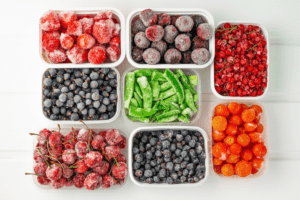10 Ways to Make Your Food Last Longer

It may be hard to believe, but nearly 40 percent of the food in the United States goes uneaten, according to research from the National Resource Defense Council. But how is it possible that so much food ends up in our trash cans rather than our bellies?
Households tend to toss vegetables when they get a little limp or discolored; best-by labels and sell-by dates can be overly complicated and misleading; restaurants serve huge portions, but then have nothing to do with the leftovers; supermarkets overstock their shelves to the point where a lot of the food goes unsold. Wasted food is the single largest category of material in municipal landfills, which also produces greenhouse gases contributing to climate change.
So what can you do to fight food waste? The answer is pretty simple: make your food last longer. But how…
For this Meatless Monday, we’ve compiled a list of things you can do to help preserve your produce, give life to leftovers, and utilize every bit of your fruits, vegetables, herbs, and other perishable ingredients. By keeping food out of the garbage, you’ll save yourself money, help conserve the planet’s precious national resources, and honor the farmers, drivers, cooks, and purveyors who make it all possible.
Store Food in Glass Containers
Although plastic containers may seem more convenient, glass with a tight-fitting lid can help make sliced fruits, vegetables, or leftovers last longer. Besides retaining fewer stains and unwanted odors, glass containers can also be popped right in the microwave for easy reheating.
Understand Expiration Dates
Expiration and “best-by” dates can be confusing, but the main takeaway is that these dates generally apply to food quality, not food safety. Here’s a quick rundown: the “sell-by” date tells the store how long to display the product for sale; the “best if used by” date applies to optimum flavor or quality; while the “use-by” date signifies when the product is no longer at peak quality, according to the manufacturer. To know if a food has gone bad, inspect for mold or an off-scent.
Learn Which Foods to Refrigerate
You’ll hear a lot of conflicting advice regarding which foods to refrigerate and which to leave out at room temperature. Foods that don’t do well in the fridge are whole tomatoes, watermelon, potatoes, onions, coffee, garlic, honey, and bread. Foods that should be refrigerated are grapes, jams, nut butters, tortillas, cooked foods, sprouts, apples, eggplant, berries, broccoli, carrots, celery, and leafy greens.
Freeze Leftovers in Resealable Bags
There’s no reason leftovers should go to waste, but you may not want to eat the same slow-cooker chili, vegetable lasagna, tofu curry, or falafel fritters for a week straight. Buy a set of resealable freezer bags. You can reheat food in the bag itself, but only for 30-second increments or else you risk melting the plastic or thaw in the refrigerator overnight.
Hang Bananas Above Other Fruits
This is not just a cute way to store your fruit. Hanging bananas helps prevent bruising and delays the spoiling process.
Buy Frozen Fruits and Vegetables
For those who can’t make it to the supermarket regularly, frozen fruits and vegetables are an excellent alternative to fresh produce. Not only do they have a similar nutritional profile, frozen fruits and vegetables often come pre-chopped, saving you some prep work. These foods are easy to reheat, never spoil, and typically cost between 1 – 2 dollars per bag. Check out our list of other inexpensive plant-based ingredients that don’t go bad.
Make Smoothies
Any produce that’s on its last day can easily be pulsed into a nutritious smoothie. Try to strike a balance between sweet fruits and savory greens. A spoonful of nut butter can also help round out the flavor. Or if you have a lot of extra fruits and veggies about to go bad, put them in freezer bags to make easy smoothies.
When in Doubt, Cook a Stew
If you have extra carrots, celery, onions, or any other hearty vegetables, you’ve got everything you need for a rich, warming stew. Check out our list of 10 soups to keep you warm this winter.
Wrap Bread to Keep It from Going Stale
It’s an age-old question: How to keep bread from going stale? First, try to keep it out of the refrigerator (the cool temperatures makes it stale faster). The best thing to do is wrap your bread in a dish towel or paper bag and store in a dry place. Then you can use it to make an apple basil panini.
Make Sure Your Refrigerator Is the Right Temperature
40° F or below. Any hotter makes it possible for bacteria to grow. Plus, a warmer fridge makes your food spoil faster. If you don’t know the temperature of your refrigerator, consider buy an appliance thermometer — they’re pretty affordable.
Storage Tips to Keep Herbs Fresh
Keep tender herbs such as parsley, basil, thyme, and others fresh longer by clipping the ends and refrigerating them in a glass container filled with a bit of water, similar to a vase of flowers. You can also blend fresh herbs with olive oil and freeze for later use.
Want to know what other foods and ingredients have long shelf lives? Check out our list of Inexpensive Plant-Based Ingredients That Won’t Go Bad and Food Print’s Guide to Reducing Food Waste.
